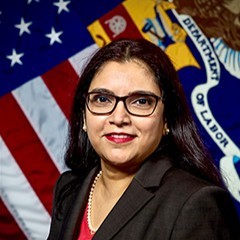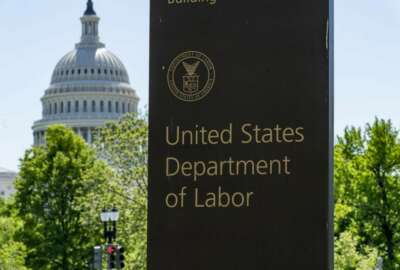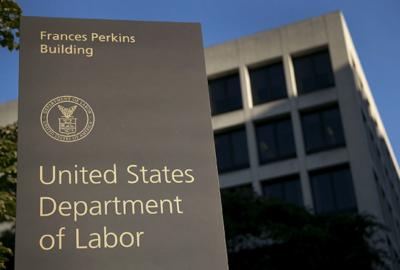A ‘sea change’ is coming for Labor’s business applications
Mangala Kuppa, the director of business application services in the chief information officer’s office for the Labor Department, was a finalist for the 2023...
Of the Labor Department’s more than 500 business applications, few were in more need of modernization than its foreign labor application gateway.
The legacy system required a special blue paper that employees had to check out at the beginning of the day and account for every piece of paper at the end of the day.
Business owners who wanted to hire foreign labor, such as farm workers, had to go to an office and fill out a paper application, which then Labor would input into the gateway program.
Labor received $3.5 million from the Technology Modernization Fund in January 2019 to upgrade the system.
“Our initial TMF award was used to make all of that electronic. We took the blue paper away. We took a 20-page certification and cut it down to a one page approval appendix. Then we set up an interagency data hub so that the U.S. Citizenship and Immigration Service (USCIS) can come in and electronically pull the data when they need it … it keeps the work the employers in their businesses and improves their life,” said Kris Mena, the branch chief for Employment and Training Administration (ETA) IT systems, during the recent Federal Tech Day. “We redesigned forms. We rewrote regulations, and then we implemented updated processing. We reimagined how they do work inside of DOL. We’re saving on an annual basis about $3 million in supplies. In the temporary labor certification program, we’ve moved people to higher value work. The permanent or green card employment program [was] set to go live and beginning accepting submissions on [May] 31. That represents about 78,000 U.S. employers, about 130,000 applications a year. Once we’re in production there, we’re expecting to save 45 days off of the processing cycle, and will save us employers about $1.5 million annually.”
This example is but one of hundreds of systems that need constant care and attention.

Mangala Kuppa, the director of business application services in the chief information officer’s office, leads that caretaker effort.
Kuppa, who was a finalist for the 2023 leadership award from Women in Technology, said the consolidation of these business applications is unleashing the real benefits of shared services across the department.
“One of the most interesting aspects of my role is really looking across all 27 agencies with the ability to find commonality, the ability to kind of improve the efficiency of operations,” Kuppa said in an interview with Federal News Network. “Mission applications support is the new thing that OCIO inherited. It’s a huge change management exercise because it’s not just about IT and systems because you got people that moved from one area to another area, the developers, the support staff or the vendors who are supporting or working directly with the agencies. Now they all moved under the OCIO umbrella. Right off the bat, I had the awareness that it is as much of a people exercise as it is a systems exercise.”
Kuppa, who started with Labor 13 years ago, has spent the last three years running the business applications services division as part of the department’s move to shared services.
Starting in 2019, Labor centralized many back office functions from human resources to financial management to technology management in its headquarter’s offices.
Laying the foundation
Kuppa said her team’s big focus right now is improving the business applications to better support the agency’s mission.
Similar to the success of the foreign labor application gateway, Labor is trying to bring in new technologies, modernize workflow processes and keep the trains running on time.
Kuppa said one of her goals is to make sure different program areas know about existing technologies or capabilities already in use so they can take advantage of them.
“The time to market and the time to benefit from the solution is going to be a lot better. We’re doing a lot of foundational work and creating capability metrics. We are establishing centers of excellence so that the technology is used for the right purpose in the right way,” she said. “We want to make sure that there is actually actual benefit that our agencies will experience with the shared services initiative, which is really the driver in doing this for the department. I feel like we are well on our way and really connecting the dots, investing more into software-as-a-service solutions, cloud-based solutions and reducing our footprint where we don’t have to spend time in jobs that can be automated, and using that power to focus on more value added work.”
She said Labor is looking at chatbots, artificial intelligence and other technologies as part of this “sea change” for business systems that’s coming.
Listening, learning from the mission
One such initiative is to improve the business systems that support mine safety and occupational safety offices.
“We have a methodology that we use to look at where we still have legacy technology, which is a huge piece in the government. We have made tremendous progress in actually modernizing that area, but we still have couple of areas where we still need to move to modern legacy technologies, which will continue to be a focus going into next one or two years,” Kuppa said. “We actually have a standard list of systems that we know that we need to modernize. We also want to continue to engage with emerging technologies. I think there is still a lot of value that needs to be uncovered with things like chatbots and where you could automate some of the mundane, administrative activities or manual activities.”
Underlying many of these efforts is the goal to provide better services to citizens and businesses.
Kuppa said an important piece to the continued success at Labor is listening to the mission or business leaders and continuing to be transparent about what the technology can and can’t help with.
“We are making sure that we are persistent and we rigorously follow up to make sure that problems are resolved. I think working to create transparency and a very trusted relationship with your customers is the key to bringing them along to a new method of doing things,” she said. “And more importantly, we listen and work to really address any concerns by explaining our plans, acknowledging when mistakes are made, but also carving out a path of how we will fix them. All of these are about actions that I think helped us create that relationship with our agency customers.”
Copyright © 2025 Federal News Network. All rights reserved. This website is not intended for users located within the European Economic Area.
Jason Miller is executive editor of Federal News Network and directs news coverage on the people, policy and programs of the federal government.
Follow @jmillerWFED






